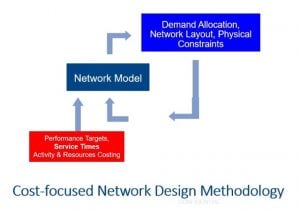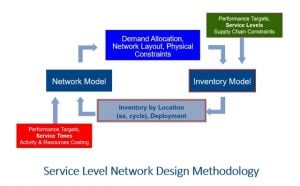What’s Wrong with Strategic Network Design?
The problem with strategic network design is when it accounts for service time but not service level. That is, it accounts for the time it takes to serve customers, but not the probability that a certain percentage of the orders will be delivered within that time. It optimizes the network, but it doesn’t optimize inventory across the network – a shortcut that can lead to a different network once the inventory is optimized. Here’s why.

This is a cost-based linear model that considers alternative cost options and optimizes resource utilization. But it uses simplistic non-optimized inventory and customer service level models that consider average inventory coverage (such as two weeks) and defines the size of the warehouse to handle that coverage. Some would claim that this is sufficient and optimizing inventory in strategic studies is not that important because those details are not important. Service levels are roughly estimated, with the assumption that they will become more precise later on in tactical and operational planning. But this is a flawed approach, because approximate service level assumptions can dramatically alter the inventory flows across the network and the allocation to the warehouses.
Service level modeling optimizes against both service time and service level constraints, yielding the lowest cost network for these objectives. It uses a non-linear model to clarify the impact of inventory because inventory to service trade-off models are discontinuous, making linear models ineffective. Instead the inventory model defines the optimal allocation of inventory in the network between the different echelons for each individual product.

Also consider, fueled by the “Amazon Effect”, there is more long tail inventory than ever before and service level is especially important for allocate inventory to insure availability of these items. Multi-echelon inventory optimization positions the inventory at the specific location and to the right level to guarantee the target service level to the end customer—an important KPIs in today’s marketplace. In designing the network, it considers not only inventory cost but the opportunity cost of lost sales or below target service levels. To achieve those target service levels, strategic supply chain network design must focus on the optimal allocation of inventory across the multiple echelons of the chain. This can’t be done without inventory optimization.
Inventory optimization can require too much data for a simplistic tool to crunch, causing some users to shrink their data set down to specific SKUs or regions to get it to work. But with good tools (and reasonably good data) you can get the job done right.
Click below to learn more from Nucleus Research about choosing an inventory optimization tool for your needs:






